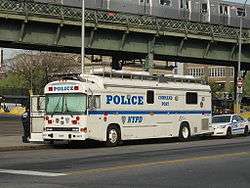Blue Bird All American
| Blue Bird All American | |
|---|---|
 Blue Bird All American Forward Engine (2009 model) | |
| Overview | |
| Manufacturer |
Blue Bird Body Company (1948-1992) Blue Bird Corporation (1992-present) |
| Production | 1948-present |
| Body and chassis | |
| Doors |
Single door Two door (export) |
| Floor type | High floor |
| Chassis |
Forward Engine: Blue Bird (1952-present) Rear Engine: Various (to 1988) Blue Bird (1988-present) |
| Related | Blue Bird Wanderlodge |
| Powertrain | |
| Engine |
|
| Capacity | 54-90 (school bus) |
The Blue Bird All American is an American school bus produced by the Blue Bird Corporation (originally Blue Bird Body Company). Introduced in 1948, the All American is the longest-produced transit-style (Type D) school bus by an American manufacturer. While not the first to use the transit-style design, the All American popularized it through most of the United States during the mid-20th century. It is produced in both a front engine-version and a rear-engine version.[1]
In October 2012, Blue Bird revealed the sixth and current version of the All American, which entered production as a 2014 model.[2] Previous major updates were introduced in 1952, 1957 (with upgrades in 1962 and 1977), 1989, 1999, and 2008.
Development
In the 1930s, to expand student seating capacity in school buses, manufacturers developed "forward control" school buses. By modifying conventional truck chassis, the engine was placed next to the driver and the front axle moved rearward of the entrance door. This allowed for the use of greater capacity within the same overall length and better forward visibility; the shorter wheelbase gave them improved maneuverability. In 1932, Crown Coach introduced the Supercoach alongside a similar design by Wayne Works; Gillig introduced a design with a rear-mounted engine. In 1937, the Crown Supercoach was expanded to a capacity of 79 passengers, becoming one of the largest school buses of its time.
In the years following World War II, Blue Bird company founder A.L. Luce sought to develop his own forward control bus. In 1948, during a trip to Europe, he and his son George visited the Paris Auto Salon.[3] One of the vehicles on display was a front-engine motorcoach (either Van Hool or Jonckheere bodywork) with a General Motors chassis built in an Opel factory in Belgium.[3] Inspired by the design, A.L. Luce sought to develop uses for the chassis as a school bus; however, the Luces learned that it was a model specifically for export markets.[3]
In an effort to reverse-engineer the vehicle, A.L. Luce purchased the Paris Auto coach from the body manufacturer in order to ship it to Blue Bird in Fort Valley, Georgia.[3] Moving past the bodywork, Blue Bird engineers found that the Opel chassis shared much in common with Chevrolet medium-duty trucks converted to forward-control; the front axle was widened and modifications were made to the steering gear. In a unique feature, the transmission was shifted by remote control.[3]
Due to its commonality with the Opel design, Blue Bird chose Chevrolet as the initial chassis for the forward-control prototype.[3] The first prototype, named Blue Bird All American, was completed in 1949. Plagued by engineering issues, the All American did not enter full production until 1950.[3]
First generation (1950-1956)
For 1950 and 1951, the All American saw relatively little marketplace success. A key factor slowing its production and sales was its method of production. While sharing a chassis with any cowled-chassis Blue Bird using a Chevrolet/GMC chasssis, the frame of the All American had to be stripped bare and converted to a forward control layout before the body was fitted; this also meant that nearly every chassis component had to be re-checked for functionality.[3]
In order to improve quality and cut down on production time, Blue Bird ended use of second-party chassis in 1952 in favor of one designed and produced by the company. Allowing for the use of engines and powertrains from a variety of suppliers, Blue Bird also redesigned the All American for the first time.[3] The roof was extended further forward, expanding the entryway, entry door, and allowing for a much larger windshield. In the chassis redesign, Blue Bird expanded the overall capacity of the All American, with some versions seating up to 72 passengers.
Second generation (1957-1989)
| Second Generation | |
|---|---|
 Early 1980s All American Rear Engine | |
| Overview | |
| Manufacturer | Blue Bird Body Company |
| Production | 1957-1988 |
| Assembly | Fort Valley, Georgia |
| Body and chassis | |
| Layout |
front-engine 4x2 rear-engine 4x2 |
| Related | Blue Bird Wanderlodge |
| Powertrain | |
| Engine |
|
| Transmission |
|
| Chronology | |
| Predecessor | Blue Bird All American (1952-1956) |
| Successor | Blue Bird All American (1989-1998) |
.jpg)
For 1957, along with the Conventional, the body of the All American was given a ground-up redesign.[3][4] Less rounded than its predecessor, the All American was distinguished by flat sides and a taller roof; the latter was done in part of an effort to allow older students and adult passengers to walk the full length of the bus standing up.[3] In an effort to improve forward visibility, the windshield was made panoramic; the two flat panes of glass were replaced by a configuration wrapping around from the entry door to the driver window. In addition, the entry door glass was enlarged to eliminate blind spots.[3] In 1958, after federal legislation permitted their use on road vehicles, quad headlights were added to the All American.[3][4]
For the next 31 years, Blue Bird would only make gradual changes to the All American. In 1961, the All American model line doubled in size as the forward-control configuration was joined by a rear-engine "pusher" configuration. It was available in diesel pusher or gas pusher configurations. Developed largely to secure bids in areas where rear-engined buses were favored, Blue Bird outsourced the chassis for the All American Rear Engine to GMC.[3][5] For 1962, the windshield of the All American was enlarged further. Two configurations became offered: a 4-pane flat glass version (standard) or a 2-pane curved glass (optional). For 1967, the roofcap above the windshield was redesigned. To better accommodate the 8-lamp warning systems coming into use, the curved roof cap seen since the 1930s was replaced with a flat, vertically oriented unit.[3] For 1968, the bodywork below the windshield was updated, leading to a new grille, vertically-stacked headlights, and a reduction in the amount of chrome trim on the front bodywork.[3]
During the 1970s, the All American saw few external changes, but more changes were made under the skin of the bus. To comply with federal regulations, Blue Bird strengthened the skin and structure of the bus for 1977 safety regulations, which also saw the addition of high-back padded passenger seats.[3] In addition, for 1977, Blue Bird changed the rear roof cap to match its counterpart in the front (borrowing bodywork from the Wanderlodge).[3] In contrast to the first All Americans, which were available in a maximum of 60 student passengers, the largest versions of the All American could now be equipped to seat 90 student passengers.
As with the previous decade, the 1980s saw relatively few changes to the All American. Following the discontinuation of the Ford Super Duty V8 in 1981, the All American was left with only the Chevrolet 427 cubic-inch V8 as a gasoline-engine offering. Concerns over fuel economy after the 1970s fuel crises had led to widespread adoption of diesel-fueled powertrains in high-capacity school buses. In response, by 1980, the All American was produced with diesel engines from Cummins, Caterpillar, and Detroit Diesel. In 1982, after being available as option for several years, a drop-sash window in the rearward row of seats became standard, replacing a fixed piece of glass.[3] In 1988, Blue Bird begins chassis production of the All American Rear Engine for the first time.
Design Epilogue
With the exception of the D3-Series All American and the EC-72 prototypes, all full-sized Blue Bird school buses produced since 1957 have derived much of their bodywork from this generation of the All American. While using a lighter-duty chassis and different interior design, the TC/2000 is also derived from this generation of the All American. In various sizes, Blue Bird has retained the same design of windshield introduced on the All American in 1962 on current versions of the Vision; it stayed on the All American to 2014.
With Blue Bird producing chassis for both versions of the All American, it marked a transition to producing chassis for all of its vehicles; with the exception of the Micro Bird, all Blue Bird vehicles are produced on company-designed chassis.[6]
Third generation (1989-1998)
| Third generation | |
|---|---|
 1989-1991 All American Forward Engine (retired, photo from Costa Rica) | |
| Overview | |
| Also called |
Blue Bird TC/3000 (export) Blue Bird CS |
| Production | 1989-1998 |
| Assembly | Fort Valley, Georgia |
| Layout |
front-engine 4x2 rear-engine 4x2 |
| Powertrain | |
| Engine |
Diesel Compressed Natural Gas |
| Transmission | Automatic |
| Chronology | |
| Predecessor | Blue Bird All American (1957-1988) |
| Successor | Blue Bird All American "A3" |

As a running change through the 1989 model year, the Blue Bird All American was given an extensive redesign, marking its first major change in 32 years. Distinguished by its horizontally-aligned headlights (first seen since 1967), the All American was given a number of changes to improve user-friendliness for both its drivers and its mechanics. In another change, the All American featured an all-new lineup of engines and transmissions.
To lower its production costs, the All American shared much of its body with its predecessor, though the drivers' compartment was completely redesigned, with only the windshield and drivers' window carrying over. To improve interior access, the engine cover on Forward Engine versions was redesigned to take up less space (as the All American used larger engines than the TC/2000, it remained much larger). To improve driver sightlines, the entry door was redesigned with larger glass panels (a feature later adopted by all Blue Bird buses). On the interior, the instrument panel was redesigned with modernized gauges; the secondary control panel was adopted from the TC/2000.
To improve serviceability, Blue Bird made a number of the front body panels removable without the use of tools for general maintenance.
In a major change, the new-generation All American dropped both manual transmissions and gasoline engines from its powertrain line (both became available on the TC/2000). As the Caterpillar 3208 and Detroit Diesel 8.2L V8 engines were discontinued during the introduction of the new All American, Blue Bird offered the Cummins C8.3, Cummins B5.9, Caterpillar 3116, and Caterpillar 3126 as a new range of diesel engines. In 1991, Blue Bird became the first manufacturer to produce a school bus fueled by a compressed natural gas (CNG) powertrain as it introduced the option on rear-engine All Americans.[7] During the late 1990s, the All American would be offered with CNG engines produced by John Deere.
To bring it in line with the TC/2000, Blue Bird rebranded the new generation of the export name of the All American to Blue Bird TC/3000. Previously, Canadian exports (the largest market outside the United States) were re-branded as Blue Bird All Canadians. As with the previous generation, the 1989 All American would change little over its production run. 1989-1991 models are distinguished by widely spaced "Blue Bird" lettering below the windshield while 1992-1998 models are identified by narrowly spaced lettering.
A3 Series (1999-2014)
| Fourth generation (A3 Series) | |
|---|---|
|
| |
| Overview | |
| Also called |
Blue Bird TC/3000 (export) Blue Bird CS |
| Production | 1999-2014 |
| Assembly | Fort Valley, Georgia |
| Layout |
front-engine 4x2 rear-engine 4x2 |
| Powertrain | |
| Engine |
Diesel Compressed Natural Gas |
| Transmission | Automatic |
| Chronology | |
| Predecessor |
Blue Bird All American (1989-1998) Blue Bird TC/2000 |
| Successor | Blue Bird All American "D3" |
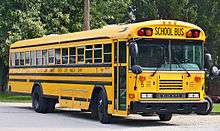
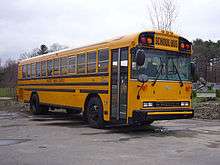
In 1999, Blue Bird introduced the fourth generation of the All American, internally designated "A3". While externally similar to both its predecessor and the TC/2000, the A3 Series represented a major structural redesign for the All American. In both front and rear-engine versions, the All American adopted a "drop-frame" chassis configuration; the portion of the frame rails supporting the powertrain were lowered in height. Compared to its predecessor (in front-engine models), the intrusion of engine housing into the drivers' compartment was significantly reduced.
To further increase forward visibility, the All American was given the larger windshield of the TC/2000, which necessitated a smaller grille. A3-Series versions are distinguished by the move of the Blue Bird lettering from between the turn signals to between the headlignts. For the drivers' compartment, Blue Bird fully redesigned the dashboard and control panels (adding larger gauges).
Throughout its production, the A3-Series All American would see little significant change. However, its introduction marked the beginning of a significant change in the Blue Bird model line; the rear-engine A3 served as the replacement for the TC/2000 rear-engine. In 2001, the TC/1000 was discontinued, with all TC/2000 and CS production ending in 2003. Initially planned for discontinuation as the D3 series made its debut, continuing customer orders for the A3-series allowed the company to keep the model into production alongside the D3-series into 2014. As the D3 was discontinued in 2013, the A3 was produced longer than its intended successor.
Along with its traditional role of a yellow school bus, Blue Bird produced the A3 All American for U.S. General Services Administration orders for government fleets as well as for export worldwide.
D3 Series (2010-2013)
| Fifth generation (D3 Series) | |
|---|---|
 | |
| Overview | |
| Also called | Blue Bird TX3 (export) |
| Production | 2008-2012 |
| Model years | 2010-2013 |
| Assembly | Fort Valley, Georgia |
| Layout |
front-engine 4x2 rear-engine 4x2 |
| Powertrain | |
| Engine |
Diesel Compressed Natural Gas |
| Transmission | Automatic |
| Chronology | |
| Predecessor |
Blue Bird All American "A3" Blue Bird TC/2000 |
| Successor | Blue Bird All American "T3" |
The new-generation 2010 All American, known by the code name "D3", was unveiled at an industry trade show in Myrtle Beach, South Carolina on October 28, 2008.[8] The exterior features the most extensive changes to the body design of Blue Bird school buses in nearly 50 years.
A notable feature of the D3 series is its headlights: the 2010 All American is the first version since the 1950s to have dual headlights instead of quad headlights and it is the first All American to have round headlights since 1988. Inside, the driver's compartment was completely redesigned for better visibility and ergonomics. Other changes were intended to make the D3 more passenger-friendly; the D3's roof has squared-off corners to increase headroom while standing up and a flat floor is available as an option in front-engine models. Both of these designs were influenced by the TC/1000 of 1997-2001.
In production for only 4 years, the D3 series was replaced alongside its A3 predecessor with the introduction of the 2014 T3 generation.
| Model Name | All American FE [9] | All American RE [10] |
|---|---|---|
| Seating Capacity | 54-90 | 66-84 |
| Overall Length (inches) | 354–487 inches (9.0–12.4 m) | 405–489 inches (10.3–12.4 m) |
| Body Width (exterior) | 96 inches (2.4 m) | |
| Body Height (depending on configuration) | 123–124 inches (3.1–3.1 m) | 126 inches (3.2 m) |
| Wheelbase | 141–232 inches (3.6–5.9 m) | 189–273 inches (4.8–6.9 m) |
| Interior Headroom | 78 inches (2.0 m) | |
| GVWR | Up to 36,200 pounds (16,400 kg) | |
| Fuel Type(s) | Diesel |
|
| Engine | Cummins ISB-10 (200–280 hp or 150–210 kW) |
|
| Transmission |
|
|
| Brakes |
Standard
Optional
|
Standard
|
T3 Series (2014-Present)
| Sixth generation (T3 Series) | |
|---|---|
|
Blue Bird All American T3FE activity buses | |
| Overview | |
| Production | 2012-present |
| Model years | 2014-present |
| Assembly | Fort Valley, Georgia |
| Powertrain | |
| Engine |
Diesel Compressed Natural Gas |
| Transmission | Automatic |
| Chronology | |
| Predecessor |
Blue Bird All American "D3" Blue Bird All American "A3" |
In October 2012, the sixth-generation 2014 All American made its debut, as a dual replacement for the D3 series produced simultaneously alongside its A3FE predecessor in production since 1999.[2][11] Although safety was emphasized with the redesign, with the vehicle given a stronger body structure and roofline, another strong emphasis was made in lowering production and service costs by increasing parts commonality with other Blue Bird products (the Vision and previous generations of the All American).
Visually, while the T3 appears to be a hybrid of the A3 and the D3 (aside from a new grille), there are more extensive changes. While an all-new round roofline results from a reinforced body structure, and the window mechanisms are redesigned. Inside, the redesigned dashboard from the D3 (now shared with the Vision) is carried over.
Previously available only as a compressed natural-gas (CNG) engine, the Cummins ISL 8.9 became available in rear-engine versions in diesel-fueled form, largely to replace the Cummins ISC 8.3.
Powertrain history
Engine
- Gasoline
- Chevrolet 427 cu in (7.0 L) Mark IV V8
- Compressed Natural Gas (CNG)
- Cummins ISL-G
- John Deere 6.8L
- John Deere 8.1L
- Diesel
- Caterpillar 3208
- Caterpillar 3116
- Caterpillar 3126
- Caterpillar C7
- Cummins VT555 "Triple Nickel" V8
- Cummins B5.9/ISB
- Cummins C8.3/ISC
- Cummins L8.9/ISL
- Detroit Diesel 8.2L "Fuel Pincher" V8
Transmission
- Automatic
- Allison AT545
- Allison MT643
- Allison 2000 Series
- Allison World/MD3060
- Allison B300
- Allison PTS 2500
- Allison PTS 3000
Export markets
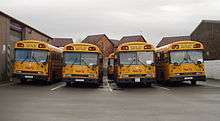
- Export Sales
Blue Bird has a history of exporting the All American to foreign markets. Outside of the United States, the name is changed. When it was first marketed to Canada, the All American was re-branded as the Blue Bird All Canadian. After Blue Bird began the production of the TC/2000 in the 1980s, the All Canadian was renamed the Blue Bird TC/3000, which also became its name in markets outside of North America. When the All American was redesigned for the 2010 model year, the name of all export versions was changed to Blue Bird TX3.
- Central American Production
When Blue Bird had a manufacturing facility located in Guatemala (Blue Bird Central America), the All American body was produced. The All Americans produced in Central America differed from those in the United States in that they utilized locally available truck chassis (Ford, Mercedes-Benz, and Hino) instead of the in-house Blue Bird chassis. These buses were used for both student transport and mass transit. Blue Bird ended bus production in Guatemala in the early 1980s.
Variants
Blue Bird CS
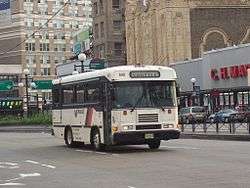
The Blue Bird CS (Commercial Series) is a commercial transit bus derived from the All American product line. During their production runs, the TC/2000 and TC/1000 also had CS derivatives of their own. Due to its high parts commonality with the school bus line, the CS is the only commercial bus product Blue Bird still manufactures in its focus on school buses. Currently, Blue Bird has not designed a transit bus variant of the D3-generation All American.
Wanderlodge

The All American school bus body and chassis served as the platform for the Blue Bird Wanderlodge, a luxury motorhome. The All American body was used from the beginning of production in 1963 until 1990, when Blue Bird switched from the All American platform to a 102 inches (2.6 m) wide motorcoach platform, 6 inches wider than the school bus body.
Comparable products

Contemporary
- IC Bus
- IC Bus FE
- IC Bus RE
- Thomas Built Buses
- Thomas Saf-T-Liner EF
- Thomas Saf-T-Liner HDX
- Thomas Saf-T-Liner EFX
Historic
- AmTran/Ward
- AmTran Genesis
- AmTran RE
- Ward President
- Ward Senator
- Carpenter/Crown by Carpenter
- Carpenter Cavalier
- Carpenter Chancellor
- Carpenter Coach RE
- Carpenter Corsair
- Carpenter Counselor FE/RE (Crown FE/RE)
- Crown Coach Corporaration
- Crown Supercoach
- Crown Supercoach Series II
- Gillig Brothers/Gillig Corporation
- New Bus, Inc.
- New Bus Chickasha FE
- Superior Coach Company
- Superior SuperCruiser FE/RE
- Thomas Built Buses
- Thomas All Star EF
- Thomas Saf-T-Liner MVP EF/ER
- Thomas Saf-T-Liner ER/WestCoastER
- Wayne Corporation/Wayne Wheeled Vehicles
- Wayne Rear Engine
- Wayne Lifestar
See also
| Wikimedia Commons has media related to Blue Bird All American. |
- Blue Bird Wanderlodge - luxury motorhome based on the All American from the early 1960s to the early 1990s
- Blue Bird TC/2000 - Blue Bird's other Type D product line (1988–2003).
- List of buses
References
- ↑ "Product Information". Blue Bird Corporation. Retrieved 2009-08-19.
- 1 2 http://www.blue-bird.com/pressrelease.aspx?item=2012[]
- 1 2 3 4 5 6 7 8 9 10 11 12 13 14 15 16 17 18 19 "Blue Bird, School Bus, History, Blue Bird Body Co., Blue Bird Corp., Wanderlodge, Buddy Luce, Albert L. Luce, Cardinal Mfg., Fort Valley, Georgia - CoachBuilt.com". www.coachbuilt.com. Retrieved 2015-08-16.
- 1 2 http://www.curbsideclassic.com/curbside-classics-american/curbside-classic-1957-blue-bird-all-american-bus-the-all-american-dream-comes-in-many-variations-and-colors/
- ↑ http://www.schoolbusfleet.com/PhotoGallery/ImageViewer.aspx?id=8&curPage=11
- ↑ "Blue Bird Corporation/About Us/History". Archived from the original on 2011-07-08. Retrieved 2010-02-21.
- ↑ "Blue Bird Corporation Environmental Stewardship Statement". Blue Bird Corporation. Archived from the original on 2010-07-24. Retrieved 2010-07-04.
- ↑ "Archived copy". Archived from the original on 2010-07-10. Retrieved 2010-05-08.
- ↑ "All-American Forward Engine School Bus Specification Sheet" (PDF). Retrieved 2010-01-14.
- ↑ "All-American Rear Engine School Bus Specification Sheet" (PDF). Retrieved 2010-01-14.
- ↑ http://www.schoolbusfleet.com/Channel/Management-Training/News/2012/10/15/Blue-Bird-to-reveal-redesigned-Type-Ds.aspx
